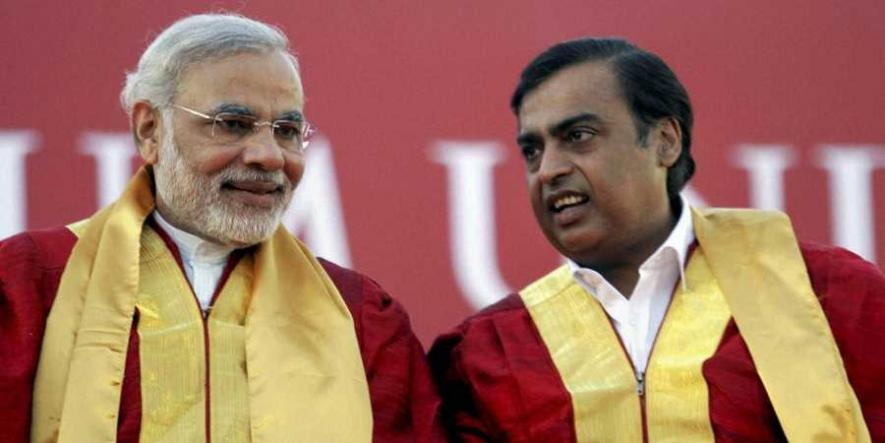BJP Govt. Delivering on its Anti-People Anti-National Higher Education ‘Vision’

The on-going controversy over the move by Ministry of Human Resource Development (MHRD) to include Jio Institute (Reliance Foundation), which is non-existent, among the list of Six ‘Institutes of Eminence (IoEs)’ is being portrayed in the media in a very isolated and one-dimensional manner.
Nonetheless, a brief overview of the announcement is still necessary.
The Six IoEs shortlisted by the Government are
(i) IISc, Bangalore; (ii) IIT, Bombay; and (iii) IIT, Delhi – in the Public Sector, and
(i) Jio Institute, Pune (under Green Field Category); (ii) BITS, Pilani; and (iii) Manipal Academy of Higher Education, Manipal – in the Private Sector
Institutes of Eminence Are Special Economic Zones for Private Education Providers
What is interesting in this choice to include Jio Institute, however, is the guidelines that shaped the deliberations of the committee tasked with shortlisting the IoEs.
For more information on the Regulatory and Legal framework, read the Newsclick articleInstitutes of Eminence: Autonomy without Accountability.
The fifth objective listed under clause 3 quite lucidly states the objective of the IoEs as, “to aim to be rated internationally for its teaching and research as a top hundred Institution in the world over time”. Instead of providing affordable and high-quality education accessible to the masses, this focus on Institutes of Eminence and ‘World Class Universities’ is “also geared towards promoting a special economic zone for Higher Education brands that may pursue commercial aims with impunity and without any public accountability,” as per the official statement by the Delhi University Teachers’ Association (DUTA).
To achieve the top world ranking, these Institutions will be provided with greater autonomy to -
Admit foreign students up to 30% of admitted students (thereby effectively reducing reservation for marginalised sections);
Recruit foreign faculty upto 25% of faculty strength (thereby reducing the employment generated for millions of Indians);
Offer online courses upto 20% of its programmes (minimum expenditure required for infrastructure);
Flexibly implement course structure in terms of number of credit hours and years to take a degree, and fix the curriculum and syllabus, among others (Flexibility means freedom from regulations, which are necessary for accountable and transparent functioning).
Each public Institution selected as ‘Institution of Eminence’ will get financial assistance of up to Rs. 1000 Crore over the period of five years under this scheme. Under this scheme, 114 applications (74 from public sector & 40 from private sector) were received in the Ministry for selection of IoEs.
Modi Government’s Higher Education Vision
The section on Education (Page 22), in BJP’s 2014 Election Manifesto, starts by saying that the “BJP believes that education is the most powerful tool for the advancement of the nation and the most potent weapon to fight poverty.”
On one hand, “advancement of the nation” is being done by relentless attempts to restore the ‘Gurukul’ system, and promote Sanskrit and Vedic Studies in both Primary and Higher Education, in the most chauvinistic way. This is besides the numerous changes in syllabi brought in by different BJP-ruled states and also at the centre.
Also Read: BJP Government Plans to Set up Vedic Education Board
On the other hand, “the most potent weapon to fight poverty” is itself being systematically denied to the poor themselves. The scheme of ‘Graded Autonomy’, approved by the UGC in August last year, grades Universities based on their rankings as per National Institutional Ranking Framework (NIRF) and National Assessment and Accreditation Council (NAAC). This scheme incentivises Higher Education Institutes to introduce self-financing courses, conduct market-oriented research, and put predominant emphasis on the employability of the student after completing his/her studies. Further, by replacing ‘grants’ from the UGC, with ‘loans’ from Higher Education Financing Agency (HEFA) for infrastructure, the Universities and Colleges will be forced to increase the fees exponentially, virtually excluding the vast majority of our population from availing quality higher education.
They might as well study in “the last tier of the universities, whose primary function would be to ensure that higher education is available to all who want it [which] would be the most regulated one. This tier will consist of the universities that are currently performing poorly and not likely to perform well on either research or employment dimension,” as stated in the ‘Three Year Action Agenda’ by the NITI Aayog.
Additionally, the ’70:30’ formula effectively limits the pay given to teachers, and adversely affects their appointment and promotion. This directly affects the quality of public-funded higher education, therefore putting another roadblock in front of students coming from socio-economically marginalised sections of society.
So, effectively, the exclusion of the poor majority from quality educational institutions is part of this administration’s plan.
Also Read: Get Ready to Pay More to Study at ‘Top Universities’
The criterion for getting good rankings itself depends predominantly on ‘outcomes’ – number of research papers published, citations, placements, financial situation and infrastructure, etc. This may seem inert, but the focus on quantifiable outcomes is a pre-requisite for commercialising the education sector, necessary to attract private capital into the sector. Hence, these provisions will directly benefit private universities, for example, the three private ‘Institutes of Eminence’. The only difference being that the ‘autonomy’ granted to IoEs “goes far beyond graded autonomy”, as stated by Prakash Javadekar himself.
Their Manifesto further mentions that “Every effort shall be made to ensure 'equality of opportunity in access and success' to all learners; creating a harmonious, and cohesive egalitarian society that practices democratic values.” The hollowness of this statement should be evident to all citizens actually fighting for an egalitarian society.
The Finance Minister in his 2016 budget speech had announced that “It is our commitment to empower Higher Educational Institutions to help them become world class teaching and research institutions. An enabling regulatory architecture will be provided to ten public and ten private institutions to emerge as world-class Teaching and Research Institutions. This will enhance affordable access to high quality education for ordinary Indians. A detailed scheme will be formulated.” He goes on to say that “We have decided to set up a Higher Education Financing Agency (HEFA) … [which] will be a not-for-profit organisation that will leverage funds from the market and supplement them with donations and CSR funds … [which] will be used to finance improvement in infrastructure in our top institutions and will be serviced through internal accruals.”
Seeing as both these promises are being steam-rolled through, regardless of the massive protests since the past four years, one can say that the BJP is holding true to its destructive higher education vision, which is anti-people and anti-national.
We often forget that it’s such neoliberal policy decisions in the fields of education, health and other social sectors that are anti-national, and not the students, teachers and activists protesting for a more socially just, inclusive and egalitarian society.
Get the latest reports & analysis with people's perspective on Protests, movements & deep analytical videos, discussions of the current affairs in your Telegram app. Subscribe to NewsClick's Telegram channel & get Real-Time updates on stories, as they get published on our website.
























